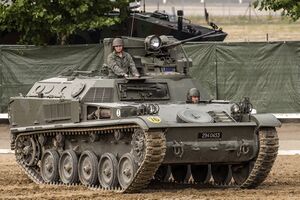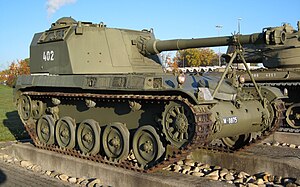Bataís APC: Difference between revisions
mNo edit summary Tag: 2017 source edit |
mNo edit summary Tag: 2017 source edit |
||
| Line 22: | Line 22: | ||
|crew = 3 (Commander, gunner, driver) | |crew = 3 (Commander, gunner, driver) | ||
|weight = 15.1 - 15.3 tons | |weight = 15.1 - 15.3 tons | ||
|armour = 10-40 mm steel plate | |armour = 10-40 mm steel plate | ||
|primary_armament = GU-1949 . | |primary_armament = <s>GU-1949</s> .35" Machine Gun on pintle mount or CU-1948 1" autocannon on attached turret | ||
|secondary_armament = 2x smoke cannisters (1962 variant) | |secondary_armament = 2x smoke cannisters (1962 variant) | ||
|engine = | |engine = | ||
| Line 31: | Line 31: | ||
|suspension = | |suspension = | ||
|clearance = | |clearance = | ||
|speed = 36 mph | |speed = *36 mph onroad, 30 mph offroad (1951 engine) | ||
*55 mph onroad, 45 mph offroad (1986 engine) | |||
|pw_ratio = 16.5 hp/t (later 25.6 hp/t) | |pw_ratio = 16.5 hp/t (later 25.6 hp/t) | ||
|vehicle_range = 225 miles (later 340) | |vehicle_range = 225 miles (later 340) | ||
| Line 41: | Line 42: | ||
Construction of the Type 1951 was delegated to the National Armor Foundry, which subcontracted the National Arms Foundry, [[Madrat Motor Design|Madrat Motors]], [[Ginearált Lionsag|General Lensing]], and [[Werthwr Stàilinobaer|Werthyr Steelworks]] for various components. | Construction of the Type 1951 was delegated to the National Armor Foundry, which subcontracted the National Arms Foundry, [[Madrat Motor Design|Madrat Motors]], [[Ginearált Lionsag|General Lensing]], and [[Werthwr Stàilinobaer|Werthyr Steelworks]] for various components. | ||
====Variants==== | ====Variants==== | ||
Several variants of the basic chassis exist, including the Type 1951/86, a which is equipped with an onboard computer, spall lining, and modern engine, optics, and track mechanics; the 1951I engineering vehicle; the 1951M, which has an ATGM mount instead of an autocannon; the 1951G, a self-propelled gun variant; and the 1951/86M, which is modernized with an ATGM launcher system. | Several variants of the basic chassis exist, including the Type 1951/86, a which is equipped with an onboard computer, spall lining, and modern engine, optics, and track mechanics; the 1951I engineering vehicle; the 1951M, which has an ATGM mount instead of an autocannon; the 1951G, a self-propelled gun variant; and the 1951/86M, which is modernized with an ATGM launcher system. The modernized variants feature a 7.62mm machine gun instead of an autocannon, while the engineering and SPG variants lack either. | ||
[[File:Panzerhaubitze AMX 13.jpg|thumb|1951G 4" SPG, | [[File:Panzerhaubitze AMX 13.jpg|thumb|1951G 4" SPG, [[National Libraries of Faneria|Teindún National Library]]]] | ||
[[File:024 Retour de manoeuvre des VCG de la 9 3. (C C Herzog). (4042969877).jpg|thumb|1951I Engineering variant, National Conscription Center I3, Muir. c. 2019.]] | [[File:024 Retour de manoeuvre des VCG de la 9 3. (C C Herzog). (4042969877).jpg|thumb|1951I Engineering variant, National Conscription Center I3, Muir. c. 2019.]] | ||
| Line 49: | Line 50: | ||
''Later variants of the Bataís became respected additions to the military's arsenal (in sharp contrast to the -2 Model), and in combat proved effective at their role as a dedicated transport and light support vehicle; still, the design was never meant to incorporate many of the systems later added, which made maintenance increasingly more complex.'' | ''Later variants of the Bataís became respected additions to the military's arsenal (in sharp contrast to the -2 Model), and in combat proved effective at their role as a dedicated transport and light support vehicle; still, the design was never meant to incorporate many of the systems later added, which made maintenance increasingly more complex.'' | ||
The Bataís was replaced in its role as an APC by the [[Capall 2002-1]] (eng. Horse/Steed) in 2004, but remains in service abroad and as a 'filler' transport vehicle for rear-line support staff. The Capall takes many of its design notes from the Bataís but is designed with the many later technological advances retrofitted into the 1962-2 in mind. | |||
==See Also== | ==See Also== | ||
[[Category:Fhainnin Army]] | [[Category:Fhainnin Army]] | ||
Revision as of 04:07, 28 December 2023
This article is a work-in-progress because it is incomplete and pending further input from an author. Note: The contents of this article are not considered canonical and may be inaccurate. Please comment on this article's talk page to share your input, comments and questions. |
| Bataís Type 1951 FTA | |
|---|---|
 A 1962 Variant Model vehicle. | |
| Type | Infantry Fighting Vehicle/Armored Personnel Carrier |
| Place of origin | Faneria |
| Service history | |
| In service | 1941–present |
| Wars | Archipelago War, Vandarch Canal Crisis, |
| Production history | |
| Designed | 1941-1951 |
| Produced | 1941-1981 |
| Variants | Type 1962 |
| Specifications | |
| Mass | 15.1 - 15.3 tons |
| Crew | 3 (Commander, gunner, driver) |
| Armor | 10-40 mm steel plate |
Main armament | |
Secondary armament | 2x smoke cannisters (1962 variant) |
| Engine | 250-400 hp depending on variant |
| Power/weight | 16.5 hp/t (later 25.6 hp/t) |
Operational range | 225 miles (later 340) |
| Maximum speed |
|
The Type 1951 FTA, colloquially the Bataís, is an armored personnel carrier produced by Faneria in the 1950s and early 1960s. Named for former Taesteach of the Republic Cillac Bataís, the Type 1951 was one of the first military systems produced at scale by Faneria after the Second Great War and subsequent economic downturn. As a result, the Type 1951 was used to fill a number of roles and saw an extended service life, continuing in a reserve role in the Fhainnin Army until as late as 2012. The system continues to be used in some foreign nations in its original configuration, both as an infantry transport and sometimes an armored police vehicle.
Design and Production
Construction of the Type 1951 was delegated to the National Armor Foundry, which subcontracted the National Arms Foundry, Madrat Motors, General Lensing, and Werthyr Steelworks for various components.
Variants
Several variants of the basic chassis exist, including the Type 1951/86, a which is equipped with an onboard computer, spall lining, and modern engine, optics, and track mechanics; the 1951I engineering vehicle; the 1951M, which has an ATGM mount instead of an autocannon; the 1951G, a self-propelled gun variant; and the 1951/86M, which is modernized with an ATGM launcher system. The modernized variants feature a 7.62mm machine gun instead of an autocannon, while the engineering and SPG variants lack either.


Service History
The original variant of the vehicle was considered underpowered, even for its time, but budget issues and the general weak stance of the military socially made spending on upgrades and refits difficult. Later variants brought the Bataís to par with competing APCs in terms of speed and horsepower, however. The original armament was gradually replaced with a turret ring allowing for a .8" cannon to be installed, with the machine gun being optional as a commander's pintle weapon. - ood
Later variants of the Bataís became respected additions to the military's arsenal (in sharp contrast to the -2 Model), and in combat proved effective at their role as a dedicated transport and light support vehicle; still, the design was never meant to incorporate many of the systems later added, which made maintenance increasingly more complex.
The Bataís was replaced in its role as an APC by the Capall 2002-1 (eng. Horse/Steed) in 2004, but remains in service abroad and as a 'filler' transport vehicle for rear-line support staff. The Capall takes many of its design notes from the Bataís but is designed with the many later technological advances retrofitted into the 1962-2 in mind.